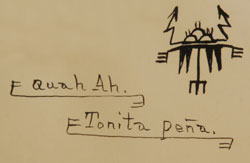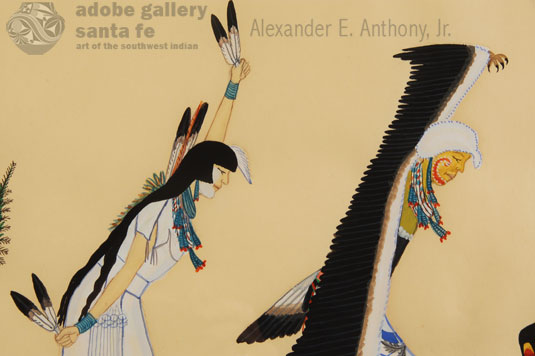Untitled San Ildefonso Eagle Dance Grouping [SOLD]
+ Add to my watchlist Forward to Friend
- Category: Paintings
- Origin: San Ildefonso Pueblo, Po-woh-ge-oweenge
- Medium: gouache on paper
- Size:
14” x 20” image;
22-5/8” x 28-5/8” framed - Item # C3875A SOLD
Tonita Peña, whose Tewa name was Quah Ah, was born in 1893 in the tiny New Mexico pueblo of San Ildefonso. The pueblo is located on the Rio Grande, just north of Santa Fe. At the age of 12, her mother passed away and her father, unable to raise her and tend his fields and pueblo responsibilities, took her to live with her aunt and uncle at Cochiti Pueblo. This was where she would spend the remainder of her life.
Tonita was the only woman in the group of talented early pueblo artists referred to as the San Ildefonso Self-Taught Group, which included such noted artists as Julian Martinez, Alfonso Roybal, Abel Sanchez, Crecencio Martinez, and Encarnación Peña.
By the time Tonita was 25 years old, she was a successful easel artist, and her work was being displayed in museum exhibitions and in commercial art galleries in Santa Fe and Albuquerque, New Mexico. She painted what she knew best—scenes of life at the pueblo. She mostly painted ceremonial dances, and occasionally depicted everyday events. She is still considered one of the best female Indian artists of all time.
Tonita was very ingenious in the manner in which she signed her paintings. After extensive and careful study of over one hundred of her paintings, it is possible to date her paintings, within reason, by the manner in which they were signed.
 Based on her signature, this Untitled San Ildefonso Eagle Dance Grouping painting had been determined to date from the early 1930s. It was during this period that she used both her Native and Baptismal names in the manner shown on this painting along with a cartouche of a rain cloud. This is one of the more comprehensive of her paintings. It was executed in the traditional Studio style of the Santa Fe Indian School. There are no background objects or ground plane. Only the human figures are shown.
Based on her signature, this Untitled San Ildefonso Eagle Dance Grouping painting had been determined to date from the early 1930s. It was during this period that she used both her Native and Baptismal names in the manner shown on this painting along with a cartouche of a rain cloud. This is one of the more comprehensive of her paintings. It was executed in the traditional Studio style of the Santa Fe Indian School. There are no background objects or ground plane. Only the human figures are shown.
The colors are still very strong and vivid. Tonita painted the female dancer in a dance position mimicking the male dancer in front of her—both with arms extended in the same manner.
Condition: very good condition for its age
Provenance: from a gentleman from Denver, Colorado
Recommended Reading: Through Their Eyes—Indian Painting in Santa Fe, 1918-1945 by Michelle McGeough, Wheelwright Museum of the American Indian, 2009

- Category: Paintings
- Origin: San Ildefonso Pueblo, Po-woh-ge-oweenge
- Medium: gouache on paper
- Size:
14” x 20” image;
22-5/8” x 28-5/8” framed - Item # C3875A SOLD



